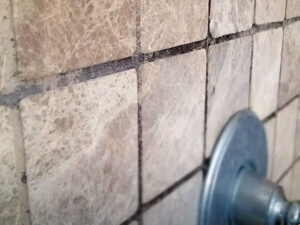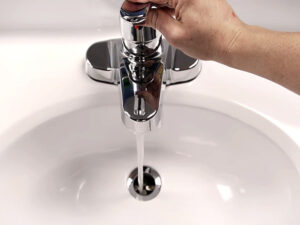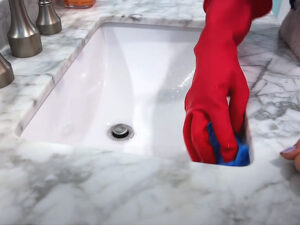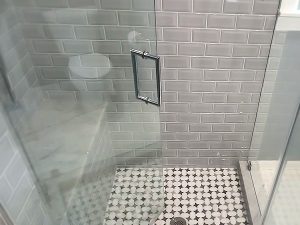Hair dye accidents have happened to me frequently in bathrooms, from accidental splatters to stubborn stains. Over the years I’ve learned effective strategies and tactics for successfully removing them on various bathroom surfaces. I am eager to share this knowledge and provide step-by-step instructions on how you can easily eliminate those pesky hair dye stains in your own bathroom and restore its original state. Let’s get going!
Understanding the different bathroom surfaces and their reactions to hair dye stains
Importantly, different surfaces react differently when exposed to hair dye. Bathroom surfaces like tiles, walls, countertops, and floors all possess different finishes and properties which could alter how quickly stains can be removed or absorbed by their surfaces.
Porous surfaces such as grout between tiles, and unfinished wooden, or stone countertops that have not been sealed can absorb hair dye easily, making removal more challenging. In contrast, non-porous surfaces like ceramic tile glazed surfaces finished wood surfaces, or sealed countertops often contain barriers that prevent stain seepage through and make cleaning them much simpler.
The finish and color of bathroom surfaces also play a factor in how hair dye stains appear and are removed, with light-colored surfaces more readily showing them off while darker surfaces typically cover them up if left too long without being properly cleaned.
Understanding these distinctions is vital in selecting appropriate cleaning products and approaches to safely remove hair dye stains from your bathroom without harming its surfaces. A misstep could result in discoloration or etching on certain surfaces.
We will discuss specific tips and techniques for removing hair dye from various bathroom surfaces. We will consider their individual characteristics and reactions. Always test new products or cleaning methods on small areas before expanding its usage to larger surfaces.
How to remove fresh hair dye stains from bathroom surfaces easily in just a few simple steps
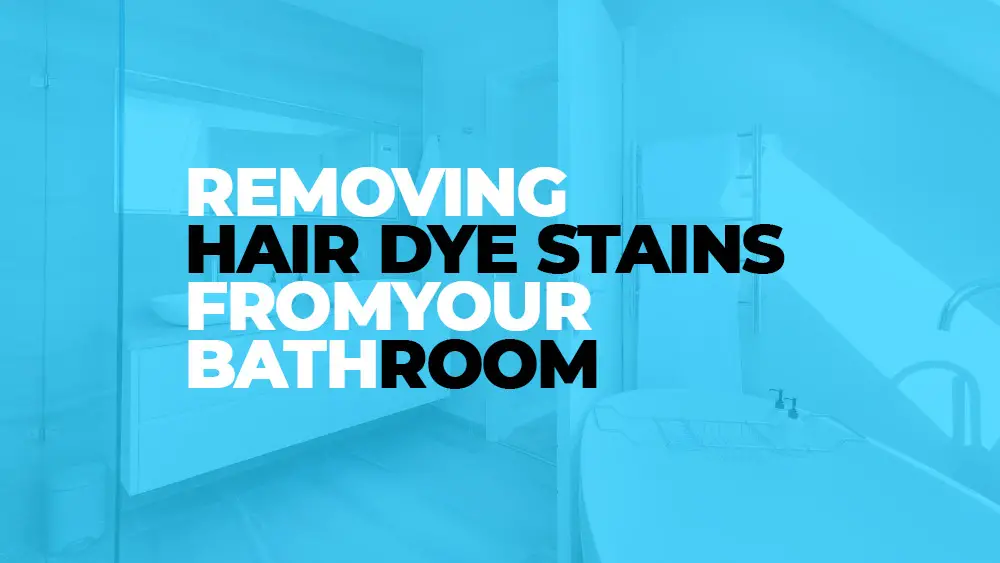
Hair dye stains on bathroom surfaces can leave unsightly marks. Here are some easy and quick solutions to remove fresh hair dye stains if you have recently experienced an accident with hair dyeing.
Wipe it off immediately: Act quickly to prevent hair dye stains. Grab a paper towel or clean cloth as soon as you notice a stain, blotting gently with it to remove the dye without vigorous rubbing – as this could spread its color further and be more difficult to remove than expected. For best results, wipe along the same direction of the stain to avoid any smudging!
Use mild detergents or dish soaps: If the stain persists after being blotted with a clean cloth, combine some drops of soapy solution into water for an easier application process. After applying it to dampened towel material, gently dab at it from the edges towards the center until the stain is gone. Avoid acidic or abrasive cleaners, which could damage bathroom surfaces.
Try white vinegar: White vinegar can be an effective solution to remove hair dye stains from bathroom surfaces. Combine equal parts white vinegar and water in a spray bottle and apply directly onto any stained areas, waiting a couple of minutes for it to set before blotting with a damp towel and rinsing off with water afterwards for optimal results. Rinse to rinse away any leftover vinegar residue.
Apply baking soda paste: Baking soda can be used to form a paste that will help remove hair dye stains on bathroom surfaces. Simply mix enough baking soda to form a thick paste that you can apply directly to stains; allow it to sit there for 15 minutes, scrub gently with a soft cloth or brush, and rinse out afterwards with water.
Use a magic eraser: Magic erasers can help remove tough stains such as hair dye. Simply wet the magical eraser before gently rubbing in circular movements until stains have been lifted without damage to bathroom surfaces or glossy or delicate surfaces. It should then work its magic without dulling or scratching these areas! Be wary when using on glossy or delicate surfaces though as overspray may dull or scratch them further.
Try hydrogen peroxide: Hydrogen peroxide may help remove hair dye stains on bathroom surfaces. Simply combine equal parts hydrogen peroxide and water in a spray bottle and spray onto the stain; allow to sit for several minutes, and wipe away with a soft cloth afterward to rinse the area off completely with water to ensure there’s no remaining residue.
Consider commercial stain removal products: Many commercial stain removal products exist that specialize in eliminating hair dye stains from surfaces in bathrooms, so follow their instructions and select one appropriate to that surface. When using any commercial cleaners or disinfectants make sure that gloves and ventilation are worn – or consider wearing protective gear while working.
Make Preventative Measures: Once the stain from your hair dye has been successfully eliminated, take preventive steps to protect yourself against future accidents. Before dyeing your hair again, cover bathroom surfaces with drop cloths or protective plastic to guard against splatters; be extra vigilant as splatters may occur when dyeing over sinks or stainless steel surfaces that will not stain.
Also Read: Natural Ways to Remove Rust Stains from Bathroom
How to Remove Set-In Hair Dye Stains Step-by-Step Guide
Removing stubborn hair dye stains from the bathroom can be challenging, particularly if they haven’t been addressed for some time. With patience and persistence, though, they can be eliminated to restore back to its original state. This step-by-step tutorial will assist in doing just that!
Prep the area: Start by cleaning any dirt or debris off of the stain surface, using mild dish soap or detergent mixed with water for best results. Rinse this area under running water before patting dry with a soft cloth.
Utilize a Stain Remover: There are numerous stain-remover products on the market designed to effectively eliminate stubborn stains like hair dye. Make sure your stain-removing product is suitable for the surface being treated and apply generously; allow to set as recommended by the manufacturer.
Scrub the stain: Use a soft cloth or brush, using circular motions, to scrub away at any stains on delicate or glossy surfaces without scratching them or scratching through. Scrub until the stain begins to come off.
Rinse with water: Rinse thoroughly with water after using a stain remover. Rinsing with water will remove any loose dye particles that may have come loose during cleaning, and any remaining residue can be easily wiped off using a sponge or cloth.
Repeat as necessary: If the stain persists, repeat this process until it has been completely eliminated. Be patient and persistent as this may take several attempts before success!
Polish and protect: Once the stain has been successfully removed, polish and protect its surface as necessary. If it was on a countertop surface you may wish to polish or use a sealer to protect it from future stains.
Prevent future stains: Take proactive steps to avert future stains by protecting bathroom surfaces with fabric or plastic drop cloths or dyeing hair in another room over stain-resistant surfaces or cloths.
Proper technique and patience are necessary for successfully removing hair dye from bathroom surfaces, especially stubborn stains such as those caused by set-in hair dye. By following this guide step-by-step and using stain removers as directed herein you can successfully eliminate stubborn hair dye stains in your bathroom.
Restoring Shine: After Hair Dye Stain Removal, Clean and Polish Bathroom Surfaces To Restore Shine
As soon as the hair dye stain is gone, it is important to give your bathroom surfaces their original shine back by cleaning and polishing them. Here are some helpful tips on cleaning and polishing bathroom surfaces.
Surface Cleaning: Begin by using mild soap or bathroom cleaner to wash away any remaining traces from stain-removal efforts, then scrub with a soft sponge or cloth until all spots have been eliminated.
Rinse thoroughly with water: Doing this will protect against damage or discoloration caused by residue that might accumulate on surfaces and help avoid discolorations or damage to them from residue build-up.
Dry the surface: After rinsing the surface, wipe it down with a dry, clean cloth to avoid water stains and streaks. This step will help ensure the long-term success of cleaning efforts.
Polish when necessary: To maintain shiny countertops or faucets, for instance, special cleaners designed specifically for their material may be needed to bring their shine back up. Use a microfiber or soft cloth according to manufacturer instructions when applying polish.
Protect the surface: Consider sealing or coating it with a protective sealant to help ward off future damage and stains, such as natural stone or grout that’s porous in nature and easy to stain easily. Sealing can make maintenance simpler while repelling stains more effectively.
Once the hair dye stain has been eliminated, restore its shine by cleaning, polishing and protecting it – this will keep it looking brand new for many years! Always follow the manufacturer’s instructions regarding care and cleaning – take preventive measures like using protective covers or dyeing your hair elsewhere to prevent future stains from appearing!
Also Read: Easy Ways to Remove Rust Stains from Bathroom Floor Drain
Precautionary Measures: How to avoid hair dye stains in the bathroom
Hair dye stains in the bathroom can be challenging to eliminate, but with some precautions, you can help reduce or avoid their appearance altogether. Here are a few tips that may help.
Cover surfaces: Before beginning hair dying in your bathroom, ensure all surfaces are protected by using drop cloths or plastic protective covers to avoid accidental spills and drips of dye onto countertops, sinks, and floors. Tighten any covers tightly for optimal results!
Set Aside a Specific Space: Designate one area in your bathroom specifically for dyeing hair, such as near the sink or washable surface, for proper ventilation. Avoid dyeing hair on porous or absorbent surfaces like carpet or untreated wood that can stain easily.
As wear protective clothing: wear dark-colored clothing you don’t mind getting stained; add an old cape or apron for additional coverage against dye leakage; use gloves as protection from getting direct contact with hair dye.
Clean spills immediately: Spills should be immediately cleaned up; accidents do occur. If hair dye is spilled into the bathroom, take quick action to wipe up the mess as soon as possible using a wet cloth or sponge, taking care not to spread any more of its color around. Use gentle products, rather than harsh ones which could damage surfaces further.
Rinse Your Hair Thoroughly: After coloring your hair, be sure to rinse any tools or containers you used, along with the water used in dyeing it thoroughly in a sink or on another washable surface to avoid dye splattering.
Use hair dye removers: Hair dye removers are your go-to solution if your bathroom surfaces become stained by hair dye. Choose one specially tailored to the surface type you are working on; harsh chemicals or abrasive cleaning agents could cause irreparable damage; follow all manufacturer instructions when selecting one.
Prevent your bathroom from smelling of hair dye by taking these preventive steps. Preventing hair dye stains is far better than treating them, and any extra effort could save both time and effort in the future.
How can you stop hair dye stains from spreading onto the walls of your bathroom?
As soon as hair dye stains appear on bathroom walls, swift and effective action is required to stop their spread. You can do just that by following these steps.
Quick Action Needed: If hair dye accidentally spills onto your bathroom walls, be quick in your response by wiping it off with a dry and clean cloth or sponge as quickly as possible – do not allow it to spread any further! Be cautious not to cause further staining.
Avoid Rubbing: When cleaning hair dye from walls, take caution not to rub or scrub vigorously as this could spread the stain further. Instead, dab at it gently using a sponge or cloth until all traces of staining have been eliminated.
Use gentle cleaners: Avoid harsh and abrasive cleaning agents on bathroom walls as these can harm paint or wallpaper. Instead, opt for mild cleaners like water mixed with dish soap or baking soda as these could provide more lasting solutions.
Test in an inconspicuous area: Before using any cleaner to clean your bathroom walls, always test it in an inconspicuous area first to ensure it won’t cause discoloration or other forms of damage to the wall surface. By doing this, you can ascertain if it is suitable for use on bathroom walls.
Protect with drop cloths: Drop cloths can help protect walls when dyeing your hair, to avoid staining. Cover all walls around and behind where you intend to apply the hair dye for maximum effectiveness.
Be mindful of hair dye application: Hair dye should be applied carefully, taking precautions to protect walls and not get onto them. Apply the hair dye with a brush or comb, keeping a towel nearby to remove any excess product that might drip onto walls, before it has time to form drip marks on them.
Keep your bathroom neat by taking steps to prevent hair dye stains from spreading further.
What steps can be taken if hair dye has deeply penetrated my bathroom surfaces?
Here are a few strategies for successfully removing hair dye stains that have become deeply embedded on bathroom surfaces.
Act Fast: Acting quickly when encountering hair dye stains on the bathroom walls is key in order to avoid further setting and make removal more challenging. Doing this could prevent deeper set stains from setting further and becoming harder to manage later.
Apply specialized cleaning products: There are specialized cleaners on the market specifically formulated to remove stubborn stains such as those caused by hair dye, so make sure that they fit your surface (tile, grout, or countertop). Check their directions on how best to use it!
Scrub gently: To prevent damaging surfaces, always scrub gently with soft sponge or cloth and apply gentle pressure with soft pressure using soft pressure on a circular motion to scrub stains off. Avoid harsh brushes or other forms of abrasive material which could scratch up surfaces.
Try natural remedies: Natural remedies may also help remove deeply embedded hair dye stains on bathroom surfaces, including baking soda and water mixed to form a paste which can then be applied directly over the stain and left for it to set before being gently wiped off with a towel. Lemon juice or vinegar mixed with water may also work for cleaning certain surfaces.
Seek professional help if needed: If the stain persists despite multiple efforts to remove it yourself, professional cleaners or restoration services may have the equipment and expertise necessary to effectively eliminate it without damaging the surface.
Removing deeply embedded hair dye stains requires patience, proper cleaning techniques and sometimes professional assistance. By applying immediate action you can successfully eliminate the stain and restore bathroom surfaces back to their former glory.
Final Verdict
Removing hair dye from bathroom surfaces may seem challenging, but with proper knowledge and techniques, it can be done with relative ease. Act swiftly by using appropriate cleaners, scrubbing gently, and taking preventive steps; test any potential cleaners on an inconspicuous area first and seek professional assistance as necessary; keep your bathroom stain-free by following this article’s tips!




